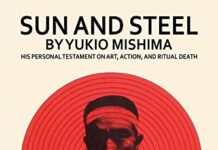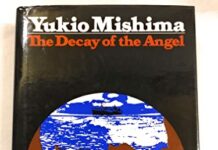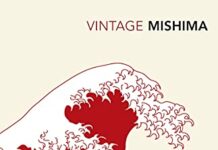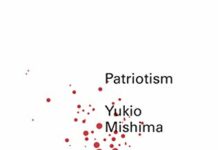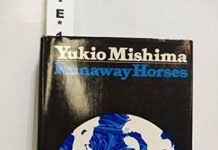
Ebook Info
- Published: 1990
- Number of pages: 330 pages
- Format: EPUB
- File Size: 0.38 MB
- Authors: Yukio Mishima
Description
Yukio Mishima’s The Temple of Dawn is the third novel in his masterful tetralogy, The Sea of Fertility. Here, Shigekuni Honda continues his pursuit of the successive reincarnations of Kiyoaki Matsugae, his childhood friend. Travelling in Thailand in the early 1940s, Shigekuni Honda, now a brilliant lawyer, is granted an audience with a young Thai princess—an encounter that radically alters the course of his life. In spite of all reason, he is convinced she is the reincarnated spirit of his friend Kiyoaki. As Honda goes to great lengths to discover for certain if his theory is correct, The Temple of Dawn becomesthe story of one man’s obsessive pursuit of a beautiful woman and his equally passionate search for enlightenment.
User’s Reviews
Editorial Reviews: Review “Surpassingly chilling, subtle and original.” —The New York Times “[Mishima’s] Sea of Fertility tetralogy. . . shines ever more obviously as one of the great works of the last century.” —William Vollman From the Inside Flap he Japanese experience from the eve of World War II through the degradation of the postwar era. From the Back Cover Dramatizes the Japanese experience from the eve of World War II through the degradation of the postwar era. About the Author Yukio Mishima was born in Tokyo in 1925. He graduated from Tokyo Imperial University’s School of Jurisprudence in 1947. His first published book, The Forest in Full Bloom, appeared in 1944 and he established himself as a major author with Confessions of a Mask (1949). From then until his death he continued to publish novels, short stories, and plays each year. His crowning achievement, The Sea of Fertility tetralogy—which contains the novels Spring Snow (1969), Runaway Horses (1969), The Temple of Dawn (1970), and The Decay of the Angel (1971)—is considered one of the definitive works of twentieth century Japanese fiction. In 1970, at the age of 45 and the day after completing the last novel in the Fertility series, Mishima committed seppuku (ritual suicide)—a spectacular death that attracted worldwide attention. Read more
Reviews from Amazon users which were colected at the time this book was published on the website:
⭐I got the next book in the newly-printed vintage series with the gorgeous covers. Although not indicated, that book is translated by someone other than Michael Gallagher, the one who did Spring Snow and Runaway Horses in the vintage series. I consider this a bait-and-switch. I was enjoying the first two books, translated by Michael Gallagher, then I get stuck with this without warning? I’m not going to go into detail, but I get the feeling that these translators are trying really really hard to write poetically (at the expense of the reader). This is the sentence that put m over the edge: “He glimpsed something red outside the car window, and looking out, saw a river and among the coconuts with trunks of flaming red bordering the road baboonlike, the smokey scarlet of poinciana along the bank.” They prefer shoving adjectives down your throat to calling a tree a tree. The worst of it is that kind of stuff interseprsed with bland description. So, if you can, find another translator.
⭐In this third novel of the Sea of Fertility tetralogy by Yukio Mishima, main character Shigekuni Honda is forty-six years old. It is now 1940, and Honda has matured into a successful lawyer and judge in the years since 1912 – 1914, when he was first introduced as the schoolboy friend of Kiyoake Matsugae, the son of a samurai family. Kiyoake, however, died at a young age in Spring Snow, and his death has haunted Honda for the rest of his life. Runaway Horses, the second novel of the tetralogy, takes place during the economic crisis in Japan of 1932 – 1933. In that novel, Honda sees Isao Iinuma, the nineteen-year-old son of Kiyoaki’s former tutor, as the physical reincarnation of Kiyoaki.The Temple of Dawn opens in 1940, immediately preceding World War II. Honda is still trying to develop his own beliefs about life, death, love, the transmigration of souls, and reincarnation. War is imminent now, as Japan, Germany, and Italy have signed a treaty against the Americans. On a business trip to Bangkok, where he also hopes to meet Prince Pattanadid and Prince Krisada, former school friends from his youth, he discovers that the Thai royal family has gone to Switzerland. Only a “mad princess,” age seven, lives in the palace – a virtual prisoner – claiming publicly that “I’m not really a Siamese princess. I’m the reincarnation of a Japanese, and my real home is in Japan.”Detailed discussions of Buddhism and its offshoots pervade the beginning of the novel and continue as Honda decides to travel to Calcutta, Benares, and the Ajanta caves in India, where he continues his exploration of reality, death, love, transmutation, and reincarnation.Part II, takes place twelve years later, in 1952, on Honda’s fifty-seventh birthday and continues to 1967. Honda, now living in a house facing the magnificence of Mount Fuji, is retired, still pursuing his philosophical inquiries. The relationship of sex and death become more personal as Honda becomes infatuated with a seventeen-year-old teenager whom he now believes is the next incarnation of Kiyoaki and Isao. Ying Chan, also known as Princess Chantrapa II, is the “mad princess” he met formerly in Bangkok when she was only seven. Now seventeen, she is studying in Japan.Set as it is in the period before and after World War II, but completely skipping over the war itself, the novel has more detailed philosophical analysis than it does narrative action, and some readers of Spring Snow and Runaway Horses may weary of these detailed philosophical discussions. Mishima himself seems to be trying to work out his own ideals and reconcile himself to a different life in postwar Japan. A believer in the old samurai traditions, Mishima despaired of the growing western influence and he never forgave the emperor for denying his divinity when he signed the treaty ending the war. Just after Mishima finished the final novel in this “Sea of Fertility” tetralogy, the Decay of the Angel on November 25, 1970, he disemboweled himself in a gruesome ritual suicide–seppuku–committed in the presence of four members of his private army. He was then beheaded, in accordance with ritual.
⭐In THE TEMPLE OF DAWN, the third book of Yukio Mishima’s “Sea of Fertility” tetralogy, we find Shikeguni Honda on business in Thailand. Six years after the death of Isao Iinuma, the former judge is now a successful lawyer, but his interest in practising law is shaken when he meets Ying Chan, a Thai princess who is the second reincarnation of Kiyoaki Matsugae. THE TEMPLE OF DAWN differs greatly from the first two books of the tetralogy. While SPRING SNOW and RUNAWAY HORSES focus mainly on their tragic young men done in by fatal youthful flaws, love and idealism respectively, Honda is the central figure of this volume. All events are filtered through his eyes, and what little we learn about Ying Chan comes from his desperate musings. In its chronology this third volume also differs, for while the first two volumes take place within a span of a couple of years, THE TEMPLE OF DAWN leaps from 1939 through the war years to 1952, and ends with a shocking revelation in 1967.Honda has changed a lot since we last met him. Right off the bat Mishima tells us that the death of Isao turned Honda from a idealistic man of reason to a nihilist, and nihilism is finally revealed as the big theme of the cycle. Honda continues to change as he grows older in this volume, and this process of growing old, of questioning earlier assumptions, and of searching for some answer to life’s mysteries makes for a fascinating plot. Readers will be shocked by the behavior of the protagonist, his wife, and their social circle. This is a novel where every nearly every page punches the reader in the cut, and Mishima appears as much a master of apparently casual revelations as Gene Wolfe. He is also a master of the love story, for love affairs in this book, twisted though they be, come out as much more realistic than Kiyoaki’s doomed affection for Satoko.But beyond the individual personages of the book and their foibles, Mishima wants the reader to consider universal principles of philosophy. Honda spends the war years in a haze, reading through the Buddhist canon and trying to figure it all out as his country is battered around him. While one can enjoy THE TEMPLE OF DAWN without too closely paying attention to ideas of samsara and the self, the novel richly rewards repeat reading. And finally, the book stands out for its amazing ending. I won’t give it away, but I will say that Mishima brilliantly alludes to his earlier writings, reinforces his thoughts on “cosmic nihilism”, and even pays a tribute to his mentor Yasunari Kawabata.All in all, this is the finest book of “The Sea of Fertility” that I have read so far, and I really can’t recommend it enough. Pick up SPRING SNOW if you haven’t yet, and other readers can continue on through this one without fear.
⭐Rereading this volume 3 of Mishima’s masterpiece after 35 years in this fantastic translation of the highest literary quality feels like finally reading Mishima’s writing itself, not just its shadow in another language.One of the best books I have read the Sea of Fertility is comparable in scope only to Proust’s ‘Recherche.’
⭐As great as Mishima was, his penultimate novel reveals the decline of his literary powers. In my opinion this book is slightly ponderous in exposition and the reincarnation plot premise (which works well over the first two books of the series) becomes laboured. Worth a read for Mishima enthusiasts, although if you are buying Mishima for the first time I would recommend one of his earlier masterpieces such as The Temple of The Golden Pavilion, Forbidden Colours, or his preceding novel Runaway Horses.
⭐Somewhat heavy going at times, elliptical in places, the writing on Hindu/Buddhist philosophy is interesting but becomes rather tedious. Yet at its best shows the poetic lyricism and deep thought so characteristic of Mishima’s genius.
⭐I’m very satisfied
⭐Building on the theme of reincarnation, Mishima’s third installment in “The Sea of Fertility” tetralogy, set during the early years of American occupation and post-war Japan (1941-1967), begins with Honda, who, while on a work trip to Thailand, is luckily granted an audience with a young Thai princess. Convinced that the princess is a reincarnation of his childhood friend Kiyoaki, Honda sets off on obsessive, philosophical quest to understand the true nature of transmigration of souls, a journey which takes him to sacred Hindu and Buddhist religious sites in India, where he devotes himself to studying myths, legends, and ritualistic ceremonies of Kings and warriors. However, in the post-war Japanese society, reeling under poverty and destruction, Honda becomes an unexpected beneficiary of sudden wealth, and we slowly see a subtle shift in his characterization. Whereas earlier he was shown as the man of reason, resolutely wary of vagaries of emotions and fleeting passions, we now see him grapple with uncertainty and meaninglessness of life. The man who, in his extreme youth chastised Kiyoaki for his hedonistic spirit, now becomes a rich voyeur whose obsession with beauty and sensuous pleasures of the flesh of the young Thai princess leads him to a despairing end. In “The Temple of Dawn”, Mishima uses Honda’s metamorphosis and suffering to highlight Japan’s decadence in the aftermath of American occupation and its longing to achieve unity and semblance in a deeply ruptured society.
⭐A lovely well maintained edition. In mint condition . I am happy to own and display on my shelf – Thanks !
Keywords
Free Download The Temple of Dawn in EPUB format
The Temple of Dawn EPUB Free Download
Download The Temple of Dawn 1990 EPUB Free
The Temple of Dawn 1990 EPUB Free Download
Download The Temple of Dawn EPUB
Free Download Ebook The Temple of Dawn
